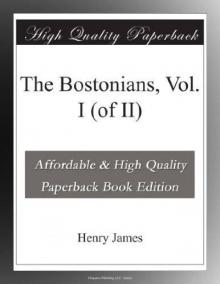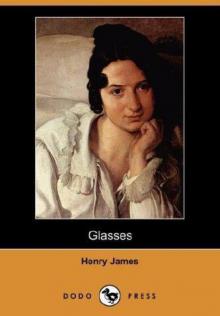- Home
- Henry James
Letters from the Palazzo Barbaro Page 3
Letters from the Palazzo Barbaro Read online
Page 3
James had an ambivalent attitude to the society in which he lived, typified by his attitude to Isabella Stewart Gardner (“Mrs. Jack”). How can one forget the portrait of this rich and powerful lady, in the habit of commanding people, whom James addressed in a half-joking and half-affectionate tone? (II, X, XVI, XXIII.) In one letter (II), James presented himself as a ‘ruminant quadruped’, one of the patient beasts always ready to pull her “triumphant car” or “tow” her gondola. But James’s humorous tone does not hide a basic criticism of that “Mrs. Jack”, who has everything, does everything, in her “preposterously pleasant career”, as a collector of the spoils of Europe.
James tried to defend himself from Mrs. Gardner’s hectic life. “How she must be flashing, or at any rate splashing, at the Barbaro!”28 he wrote to Mr. Curtis in 1897, when Mrs. Gardner had taken temporary possession of the Palazzo Barbaro. The “divine stillness” of the palace “spinned around” when the “little lady” lived in it. In 1893 James wrote to Isabella that he could imagine her at the Chicago Exhibition, with her own palace, “an infinitely more barbarous Barbaro”,29 on the top floor of which he would like to have a “small marble hall with thirteen curtains and a pink mosquito net”. Only on these conditions will he go, on no other. The little lady always on the move, busy buying Titians, Mantegnas and Vermeers, rococo chairs and cuori d’oro (golden leather hangings embossed with gold) did in fact build her own palace, a little “more barbarous” than the Barbaro. The wonderful Fenway Court, in Boston, became her own imagined and real Palazzo Leporelli.30
Many other characters appear in these letters. Henry’s brother William and their sister Alice, with whom the writer spent some time in Venice, apparently not very happily, because of the many famished mosquitoes. There are James’s American friends living in Italy: Francis Boott, the musician, and his daughter Lizzie, married to the painter Frank Duveneck; Aunt Kate, the sister of James’s mother, and other lady friends, such as Grace Norton, Sarah Butler Wister, and after 1899, the English Miss Jessie Allen. As the letters indicate, with some of these people, at first worldly conoscenze, a relation of deep friendship developed over the years, especially with the Curtises and Miss Allen.
A society of expatriates in love with Italy gradually takes shape, sprinkled here and there with exiled emperors and princes, or with visiting royalty, mixing with the few surviving members of the Venetian patrician class who had escaped ruin (not unlike the society of Venice of the present fin de siècle). This society mixes with artists, poets, writers, musicians (as it still does). In the letters we are given glimpses of this world that struck James as “a vain agitation of insignificant particles”,31 but in whose ceremonies and rites he himself participated.
The Curtises, Daniel and Ariana, are in a way the exemplary representatives of this world, in their exquisite palace, where:
“The cosmopolite habit, the modern sympathy, the intelligent flexible attitude, the latest fruit of time, adjust themselves to the great gilded, relinquished shell and try to fill it out.”
Because, James adds:
“A Venetian palace that has not too grossly suffered and that is not overwhelming by its mass makes almost any life graceful that may be led in it.”32
The Curtises, like so many other members of this cosmopolitan society, take tea with the Queen of Montenegro, sitting in a circle in front of a blinding lamp, surrounded by portraits of the royal family in their Montenegro costumes. They dine at the Layards’, at Palazzo Cappello on the Grand Canal, where the former ambassador and discoverer of Niniveh has his splendid collection of Italian paintings, among them Bellini’s Mahomet II, bought with the help of Giovanni Morelli33, and where Lady Layard wears a necklace made of the Mesopotamian seals found by her husband. They receive their “neighbour”, Countess Pisani, who lives in the same palace when she is not in the country looking after her farm. In their palazzo, Robert Browning reads his poems to a group of friends, after spending the morning on the Lido, walking along the beach, and returning, with Daniel and Ariana, in their gondola. They also take part in other society rituals that have now disappeared: the evenings of the tableaux vivants, where Ariana is a Van Dyck and a young Mocenigo girl is a Titian, while the “director”, the painter Duveneck, is a “bravo of Venice”, romantically menacing. Ariana’s letter on the tableaux vivants gives us a glimpse of a social rite which appears in Edith Wharton’s The House of Mirth?34
The Curtises are part of the group of expatriate Americans, just like Mrs. Bronson, who has learnt Italian but especially the Venetian dialect so well that she can write commediette in this dialect and stage them at home, with “monstrously clever” young players.35 These expatriates have, however, a strong animosity towards their motherland that James does not share, as he underlines in one letter (IX). To look for the possible causes of this animosity, one finds an episode where causes and effects are totally disproportionate. The Curtises seem to have left Boston—for ever—due to an offence. The story goes that Daniel climbed onto a streetcar, and finding his usual seat taken by a gentleman who did not stand up to vacate the seat, quarrelled with him, pinching his nose.36 Unfortunately the man was Judge Churchill, who took him to court. Mr. Curtis was sentenced to pay a fine or to spend one night in prison. He chose to leave Boston for ever. But there are other versions of the story, some more favourable to Mr. Curtis, such as the one where the quarrel is said to have originated with the judge not allowing a pregnant woman to sit in Mr. Curtis’s usual seat.
Perhaps in reality, the Curtises, just like so many other expatriates, were looking for a less rigid way of life, a softer life—not only in terms of the climate—which allowed them to enjoy art and culture without the sudden frosts of the New England Puritan tradition.
This world is present in James’s letters, but also in the letters of the Curtises, which cannot—and must not—be compared with the wonderful writing in James’s letters. We present here some unpublished letters by Daniel and Ariana to Daniel’s sister, Mary, because these letters too offer curious glimpses of that strange “garden of social flowers” which was the Anglo-Venetian society of that epoch. These are family letters that also tell—insisting on secrecy!—of the hoped-for purchase of Palazzo Barbaro (III), of the objects bought at an auction to embellish it, and of the secret staircase that has been discovered in the palace (IV). Together with Ariana’s notes, written in 1908, in a quick summarizing perspective, these letters not only give information on the people who frequented the Barbaro, but also on the restoration of the palace.
The quiet and familiar letters of Daniel and Ariana are followed by those of their son Ralph, the painter, all addressed to Isabella Stewart Gardner, sparkling with vivacious news and suggestions. Ralph’s is an intense fin de siècle life, with endless travelling between Paris and London, Marienbad and the Côte d’Azur (where he had a villa), Spain and Germany, for art and music, but also for hunts and dances and thermal cures, or to hear Wagner’s Tristan in Bayreuth. Ralph seems to live intensely, to want to enjoy life quickly, at all costs, while there is time. Ralph’s letters seem to foresee that the world in which Daniel and Ariana live peacefully, imagining it will last for ever, will come to an abrupt and tragic end. In May 1914 Ralph Curtis, writing to Isabella Stewart Gardner, still declares that everything is going on as usual, that there is nothing new; but in the following letter, dated September 2, 1915, in the midst of war, everything has inexorably changed. The description of Venice, seen as a “primadonna in mourning”, with all its hotels and shops closed, the golden angels covered with grey sackcloth, seems to place the final seal on the brilliant personal life of Ralph and on the more general history of a whole society. The sense is of an ending: the very sense that James expressed in a letter to Jessie Allen in 1907, beneath the discursive, even gossipy surface, James must tell Miss Allen “of the new heartbreak it is to feel this enchantress (I allude now to the terrible old Venice herself !) weave her spell just again supremely to lose her”.
The diff
erent destinies of Henry James, the Curtises, the gilded fin de siècle world, merge in the destruction of World War I.
After another war, a little girl climbed “the strikingly bold, yet strikingly relaxed” open staircase of the Palazzo Barbaro: the granddaughter of Ralph took her place in the palace. Her memoir, at the end of this book, gives us a glimpse of a palace that has survived Napoleonic plunders and spoliation, ruin and wars, to continue the tradition of art, history, and of civilization into the next century.
NOTES
1. Poliziano (Angelo Ambrogini called il Poliziano, 1454– 1494), the Florentine humanist, famous for his Greek and Latin studies, for his translations and his poetry. His masterpiece is the poem Stanze per la giostra (1494) written to celebrate the young Giuliano de’ Medici’s victory in a tournament, and interrupted because of the young prince’s death.
2. On the Barbaros, see M.L. King, Venetian Humanism in an Age of Patrician Dominance, Princeton, Princeton University Press, 1986; V. Branca, Poliziano e l’umanesimo della parola. Turin, Einaudi, 1983 and La sapienza civile, Florence, Olschki 1998; M. Tafuri, Venezia e il Rinascimento, Turin, Einaudi 1985; Una famiglia veneziana nella storia. I Barbaro, eds. M Marangoni, M. Pastore Stocchi, Venice, Istituto Veneto di Scienze, Lettere ed Arti, 1996. On Marc Antonio Barbaro see the entry by F. Gaeta, in Dizionario Biografico degli Italiani, VI, 1964, pp.110–112. On Francesco Barbaro, Marc’Antonio’s oldest son and the successor of Giovanni Grimani in the patriarchate of Aquileia, a figure of great importance in the Counter-Reformation, see the entry by G. Benzoni in Dizionario Biografico degli Italiani, VI, pp.104–106; G. Trebbi, Francesco Barbaro patrizio veneto e patriarca d’Aquileia, Udine, Casamassima, 1984. On Antonio Barbaro, the entry by G. Benzoni in Dizionario Biografico degli Italiani, VI, pp.86–89. On Napoleon’s devastations and more generally on XIX century plunders see A. Zorzi, Venezia scomparsa, Milan, Electa, 1984 (1972), and Venezia austriaca, Bari, Laterza, 1985. On the dispersals of archives and libraries see M. Zorzi, La Libreria di San Marco, Milan, Mondadori, 1987.
3. From an unpublished anonymous diary, a ms. of the Biblioteca Nazionale Marciana, in course of publication. The diary is Daniel Curtis’s. See Rosella Mamoli Zorzi, “Henry James in a ‘Venetian’ Diary”, in Henry James Review, 11, 1990, pp.101–114.
4. The great ceiling canvas, the so-called Apotheosis of Francesco Barbaro is now at the Metropolitan Museum of New York. It was in fact sold in 1866, before the palace was bought by the Curtises and therefore before James was a guest of the Curtises, although the writer seems to have considered the “pompous Tiepolo ceiling” the real thing. The other Tiepolos, the ovals in the great salon, The Offering to Juno Lucana, The Betrothal of Alexander and Roxana, The Death of Arsinoe, Tarquinius and Lucretia, were sold in 1874 and are now respectively in Pavia, Copenhagen, Washington, Augsburg; see M. Gemin, F. Pedrocco, Giambattista Tiepolo. Dipinti, Venice, Arsenale, 1993. See n. 16, p.211 and Ariana Curtis’s Notes, unpublished ms. of the Biblioteca Nazionale Marciana, published here in the original English version for the first time. On Palazzo Barbaro see G. J. Fontana, Cento palazzi di Venezia storicamente illustrati, Venice, Scarabellini, 1934 (1850), pp.119–122; E. Bassi, Palazzi di Venezia, Venice, La Stamperia, 1976, pp.57, 325, 512; P. Lauritzen and A. Zielcke, Palaces of Venice, Florence, Becocci, 1978, pp.102–107, and obviously John Ruskin, The Stones of Venice, in The Complete Works of John Ruskin, ed. by E. T. Cook and A. Wedderburn, London, Allen, 1904, vol. XI, bk. 3 of The Stones.
5. Ruskin helped Alvise Piero Zorzi to publish his Osservazioni intorno ai restauri interni ed esterni della Basilica di San Marco, Venice, Ongania, 1877 (reprinted in: Dalla Costa, La Basilica di San Marco e i restauri dell’Ottocento, Venice, La Stamperia di Venezia, 1983). On the subject see also J. Clegg, Ruskin and Venice, London, Junction Books, 1981.
6. An Interior in Venice, in P. Hills, John Singer Sargent, New York, Whitney, 1987, p.69 (n. 44) and in the catalogue Venezia nell’Ottocento, edited by G. Pavanello and G. Romanelli, Venice, Electa, 1983, pp.209–210. The painting is at the Royal Academy in London. Mrs. Gardner in Venice (1894) by Anders Zorn is at the Isabella Stewart Gardner Museum in Boston. The Barbaro Palace by Walter Gay is at the Boston Museum of Fine Arts and is published in W. Gay, Paintings of French Interiors, edited by A.E. Gallatin, New York, Dutton, 1920, n. 15. F. Latimer’s paintings are in a private collection.
7. Letters will be indicated in this introduction with the number they are marked with in this edition, in parenthesis.
8. The Grand Canal, in Italian Hours, New York, Grove Press, p.39.
9. See the photograph of the canopied bed, in the Isabella Stewart Gardner Museum collection in Boston.
10. Henry James, Letters, 1843–1875, vol. I, edited by Leon Edel, London, Macmillan, 1974, p.134, letter of September 21, 1869 to John La Farge. The reference to James’s letters will be shortened to “Edel, Letters” hereafter.
11. On the relation with Ruskin, see Leon Edel’s volumes, in particular The Untried Years (1843–1870), New York, Discus, 1978; J. Clegg, “Superficial Pastimes, fine emotions and metaphysical intentions: James and Ruskin in Venice”, in Henry James e Venezia, edited by S. Perosa, Florence, Olschki, 1987. On Tintoretto’s and James’s mannerism, see B. and G. Melchiori, II gusto di Henry James, Turin, Einaudi, 1974; L. Lepschy, Tintoretto Observed, Ravenna, Longo, 1983; Rosella Mamoli Zorzi, “Tintoretto e gli Anglo-Americani,” in Annali di Ca’ Foscari, XXXV, 1–2, 1996. On James and Venice see Leon Edel’s volumes, The Untried Years cit., The Conquest of London, The Middle Years, The Treacherous Years, The Master, all New York, Discus, 1978. Among studies entirely devoted to this topic, see M. Battilana, Venezia sfondo e simbolo nella narrativa di Henry James, Milan, Laboratorio delle arti, 1987 (1971). See also The Sweetest Impression of Life, The James Family and Italy, edited by A. Lombardo and J. W. Tuttleton, New York and Rome, New York University Press and Istituto dell’Enciclopedia Italiana, 1990, and T. Tanner, Venice Desired, Cambridge, Harvard University Press, 1992.
12. As regards composition, one should look at the passage on the San Rocco Crucifixion in the Preface to The Tragic Muse, in Henry James, Literary Criticism, French Writers, Other European Writers, The Prefaces to the New York Edition, edited by Leon Edel, with the assistance of M. Wilson, New York, The Library of America, 1984, p.1107.
13. Edel, Utters, I, p.160.
14. On Constance Woolson see Edel, The Middle Years cit., The Master cit. On January 25, 1894, the Gazzetta di Venezia announced the death of the American writer. James Fenimore Cooper was the author of The Leatherstocking Tales, among which is The Last of the Mohicans.
15. Letter to Mrs. Curtis from Casa Biondetti (1894). Dartmouth College Library, Curtis Correspondence.
16. See Alide Cagidemetrio, Black Balloons and White Doves, in Henry James e Venezia cit.
17. Unpublished manuscript by Zina Hulton, Fifty Years in Venice, p.103, Ashmolean Museum, Oxford.
18. Edel, The Master cit., pp.109–110.
19. On the evolution of James’s narrative strategies see S. Perosa, Henry James and the Experimental Form, New York, New York University Press, 1980.
20. The Wings of the Dove, Penguin Modern Classics, 1965, p.292. Subsequent page references to this novel will be printed in the text.
21. See T. Tanner, op. cit., on Eros and Venice.
22. On the identification and the function of the Veronese painting (The Queen of Sheba in front of Solomon, now attributed to Veronese’s workshop) see J. Clegg, art.cit., p.163. On the relationship between narrative and pictorial techniques, also as regards Veronese, V. Hopkins, Henry James and the Visual Arts, Charlottesville, The University of Virginia Press, 1970, pp.84–85.
23. Prefaces cit., p.1152.
24. See also The Complete Notebooks of Henry James, edited by Leon Edel and L. H. Powers, New York, Oxford University Press, 1987, p.34, and the Preface to The Aspern Papers, in Literary Criticism cit., pp.1173–1179 for the reference to Claire Clairmont and Shelley.
26. Letter to the Curtises, September 25 (no year) from Rye (Dartmouth, Curtis Correspondence).
27. See also James’s notes on “the C. F. and Katrina B. subject”, deriving from a conversation between Katherine Bronson and Constance Fletcher (in the Notebooks cit., p.208 and p.126). James eventually “used” the figure of Browning in the story The Private Life (1892) (Notebooks, p.60).
28. Letter to Mr. Curtis, August 1897, Dartmouth, Curtis Correspondence.
29. Letter to Isabella Stewart Gardner, Isabella Stewart Gardner Museum.
30. On Mrs. Gardner see M. Carter, Isabella Stewart Gardner and Fenway Court, Boston, Isabella Stewart Gardner Museum, 1925; L. Hall Tharp, Mrs. Jack, A Biography, New York, Congdon and Weed, 1965; The Letters of Bernard Berenson and Isabella Stewart Gardner 1887–1924, with Correspondence by Mary Berenson, edited by R. van N. Hadley, Boston, Northeastern University Press, 1987.
31. Edel, Letters III, p.169.
32. The Grand Canal cit., p.39.
33. Giovanni Morelli (1816–1891), Italian art critic, the author of many critical works on art, which he published in German, and the inventor of a method based on the identification of particular motifs (motivi sigla) which led to the attribution of paintings to the hand of a specific artist.

 The American
The American The Wings of the Dove, Volume 1 of 2
The Wings of the Dove, Volume 1 of 2 Frost at Midnight
Frost at Midnight Morning Frost
Morning Frost The Portrait of a Lady — Volume 1
The Portrait of a Lady — Volume 1 Fatal Frost
Fatal Frost The Europeans
The Europeans The New York Stories of Henry James
The New York Stories of Henry James Great Short Novels of Henry James
Great Short Novels of Henry James Washington Square
Washington Square The Portrait of a Lady — Volume 2
The Portrait of a Lady — Volume 2 The Ambassadors
The Ambassadors The Wings of the Dove
The Wings of the Dove The Princess Casamassima (Classics)
The Princess Casamassima (Classics) The Coxon Fund
The Coxon Fund First Frost
First Frost Henry James
Henry James The Daily Henry James
The Daily Henry James Travels With Henry James
Travels With Henry James The Reverberator: A Novel
The Reverberator: A Novel What Maisie Knew (Henry James Collection)
What Maisie Knew (Henry James Collection) The Outcry
The Outcry The Marriages
The Marriages The Wings of the Dove, Volume 2
The Wings of the Dove, Volume 2 The Bostonians, Vol. I
The Bostonians, Vol. I The Outcry: -1911
The Outcry: -1911 The Complete Works of Henry James
The Complete Works of Henry James Letters from the Palazzo Barbaro
Letters from the Palazzo Barbaro The Pupil
The Pupil The Bostonians, Vol. II
The Bostonians, Vol. II Pandora
Pandora Glasses
Glasses The Princess Casamassima
The Princess Casamassima What Maisie Knew
What Maisie Knew The Reverberator
The Reverberator The Golden Bowl - Complete
The Golden Bowl - Complete Confidence
Confidence Wings of the Dove (Barnes & Noble Classics Series)
Wings of the Dove (Barnes & Noble Classics Series) The Spoils of Poynton
The Spoils of Poynton